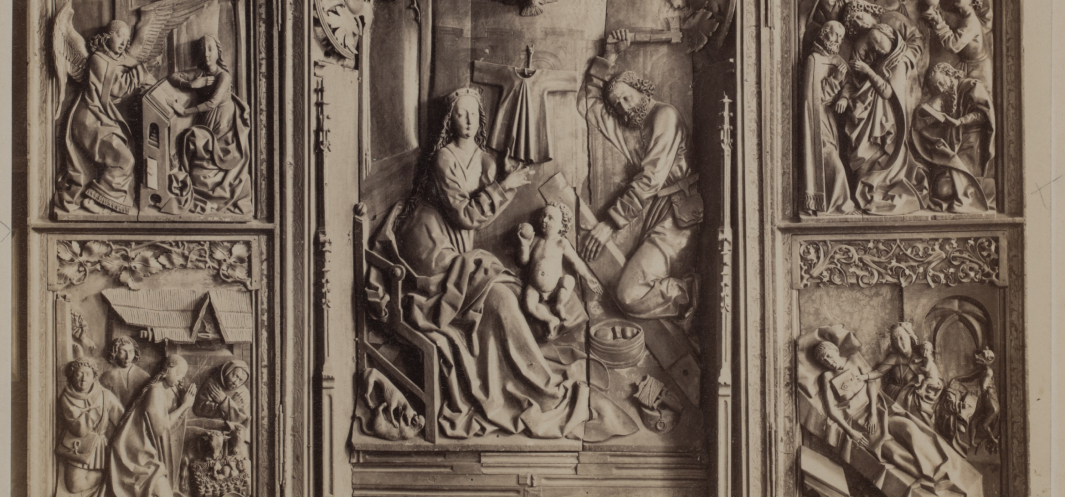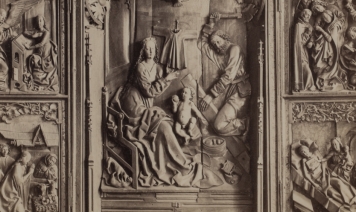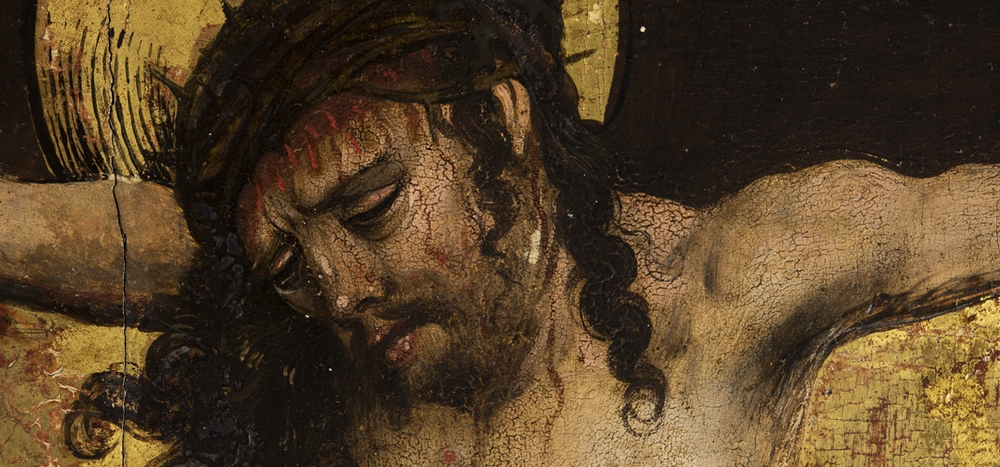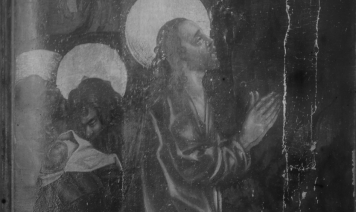Lost Sections of the Polyptych of Lusina
The National Museum in Cracow is currently in possession of two pairs of wings originally forming part of a late-Gothic retable referred to as the Polyptych of Lusina. Dated to the period between 1500 and 1510, the retable comprised the body, two pairs of wings combined to afford three views (daily, Sunday and feast day), and – in all likelihood unpreserved until the 19th century – a predella and superstructure. Despite the uncertainty whether this had been the original design of the piece, the Pentaptych continued to be displayed in such form until World War II. The daily view comprised four sections with painted images of saints: Saint Stanislaus the Bishop and Saint Anne, and Saint Florian and Saint Catherine, all within outer wings. Once opened, the wings would reveal eight painted and gilded Sunday view  sections depicting the “Passion Cycle”, its original nature with no identified analogies in painted art of the region (Małopolska). Unpatterned golden surfaces were the background for a succession of images: “Jesus Praying in Gethsemane”, “The Arrest of Christ”, “Christ before Caiaphas”, “The Judgement of Pontius Pilate”, “The Flagellation”, “The Crowning with Thorns”, “Jesus Falling beneath the Cross”, and “The Crucifixion”. The feast-day view was most representative and most ornamental in equal measure, comprising gilded polychromed relief panels. The main body of the shrine was filled with a rare representation of “The Holy Family”, the two inner wings – with four respective sections depicting “The Annunciation” and “The Adoration of Shepherds”, and “The Dormition of Mary” and “The Legend of Saint Theophilus of Adana”, all additionally embellished with woodwork components.
sections depicting the “Passion Cycle”, its original nature with no identified analogies in painted art of the region (Małopolska). Unpatterned golden surfaces were the background for a succession of images: “Jesus Praying in Gethsemane”, “The Arrest of Christ”, “Christ before Caiaphas”, “The Judgement of Pontius Pilate”, “The Flagellation”, “The Crowning with Thorns”, “Jesus Falling beneath the Cross”, and “The Crucifixion”. The feast-day view was most representative and most ornamental in equal measure, comprising gilded polychromed relief panels. The main body of the shrine was filled with a rare representation of “The Holy Family”, the two inner wings – with four respective sections depicting “The Annunciation” and “The Adoration of Shepherds”, and “The Dormition of Mary” and “The Legend of Saint Theophilus of Adana”, all additionally embellished with woodwork components.
The retable’s pre-mid-19th century history remains unknown, the piece mentioned for the first time around 1850, in the wake of the historical artefact having been donated to the Cracow Learned Society by owners of the Lusina manor. Outer wings were the first to be donated, followed by inner wings and the shrine cabinet. The Pentaptych was first shown to the general public in 1858 at the “Exhibition of Antiquity” – this was also when its first known photograph was taken. Once the Learned Society had closed its doors in 1871, the retable was donated to the Academy of Arts and Sciences, then to the National Museum in Cracow; outer wings were deposited with the Museum in 1891, the body and inner wings – in 1938. The condition of the piece necessitated repair works. Consequently, pursuant to postulations of a 1928 conservation programme (albeit it remains unknown whether it had been actually completed), the inner wings and shrine were to be restored, including an addition of a brand-new frame to connect all elements of the piece.
The successive fate of the retable was affected by World War II, and the policy of German occupant authorities stationed in Cracow. Scholars having identified Veit Stoss’ influence in the Pentaptych’s sculpted components, the piece was seized in 1940 and entered into the looted artworks catalogue as number 247. It was shown in its full-bodied version in 1941 as part of an exhibition of Veit Stoss’ art, two bas-reliefs depicting “The Dormition of Mary” and “The Legend of Saint Theophilus of Adana” in the right wing displayed at the “Altdeutsche Kunst aus Krakau und dem Karpathenland” show in the same year. Reference sources allow a conclusion that the altar had been restored in the interim period between the two exhibitions. Yet the actual date of the retable leaving Poland remains unknown.
Only the two pairs of wings were recovered after the war, the shrine cabinet with the rendering of “The Holy Family” and the “Saint Theophile of Adana” scene panel considered lost. Information about the lost fragments can be found in the Catalogue of wartime losses at number 409 (http://lootedart.gov.pl/en/product-war-losses/object?obid=409). Following repossessions, aforementioned wings were subjected to conservation works in 1947 and 1948. Ornamental bands formerly embellishing the wings were found in 1963 and reassembled in 1975. Recovered and subjected to conservation, the wings were shown at two exhibitions: “Polish Guild Art from the 14th to the 18th Century” at the National Museum in Cracow, and “Art More Precious than Gold” at Cracow’s Wawel Castle. Today, they are on display at Bishop Erazm Ciolek’s Palace, a branch of the National Museum in Cracow at Kanonicza No. 17.
Technological testing of aforementioned wings has been in progress since 2018 as part of assorted in-house projects of the National Museum in Cracow, with Dominika Tarsińska-Petruk, Ph.D., as the supervisor, in collaboration with Joanna Zwinczak of the Academy of Fine Arts in Cracow and Lanboz Laboratory for the Analysis and Non-Destructive Testing of Historical Objects (of the National Museum in Cracow). To date, works have yielded basic tests designed to identify the technique and technology behind the artwork, and determine its provenance.
The one-year project includes a schedule of auxiliary testing; determining the chronology of alterations in the Polyptych; consultations with experts in the field of 15th- and 16th-century sculpture and painting (German works included); and the drafting, editing, and translating into the German and English languages of tentative work outcomes, with intent to make them available to the general public by posting under a bespoke Polyptych tag on the National Museum in Cracow website. “Catalogue of Wartime Losses” data will be reviewed and updated. We hope that the process of disseminating knowledge regarding the lost artefact, including full comprehension of techniques and technologies recalling its original appearance, will be helpful in further quests for lost bas-reliefs.
Project executors: Dr Dominika Tarsińska-Petruk (Head), Joanna Zwinczak, Daria Kuzak and Dr Julio del Hoyo-Meléndez and Dr Anna Ryguła (Lanboz MNK)
The National Museum in Cracow received a grant of PLN 25,000.00 from the Ministry of Culture and National Heritage as backing for the project.
This project has been subsidised by the Ministry of Culture and National Heritage from the Culture Promotion Fund, a special state fund vehicle, as part of the “Researching Polish Wartime Losses” programme.





